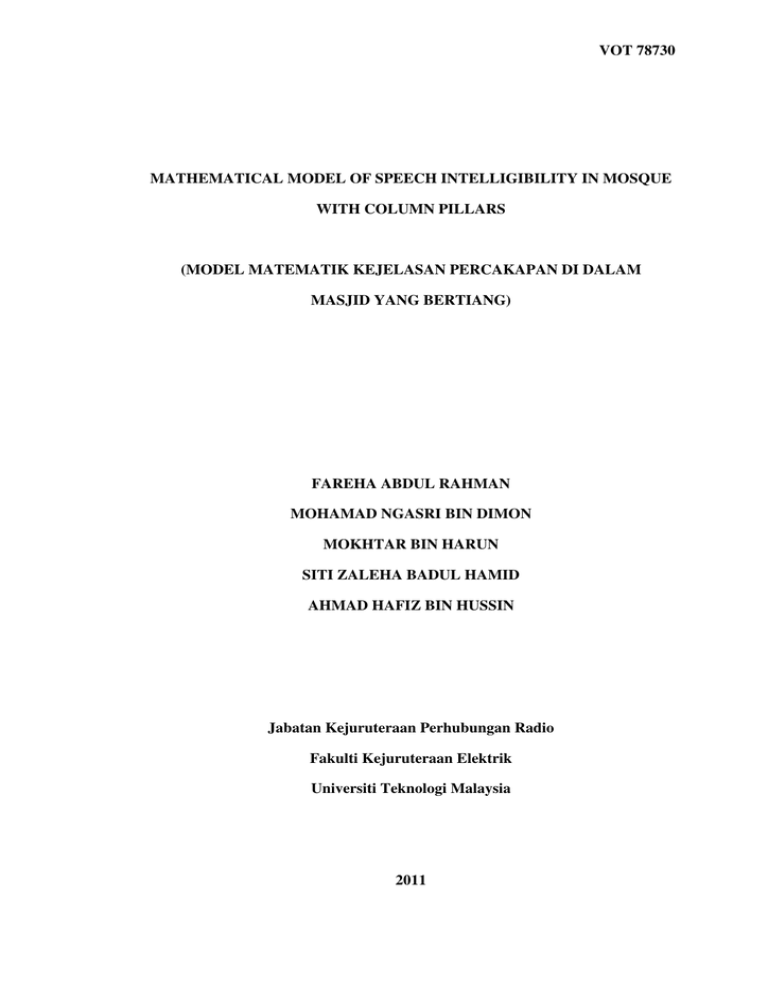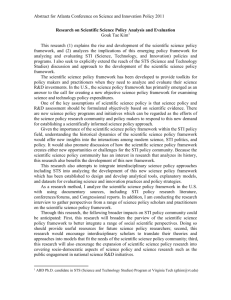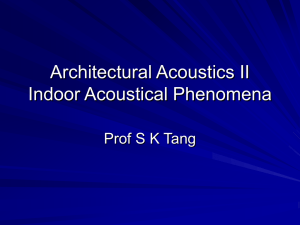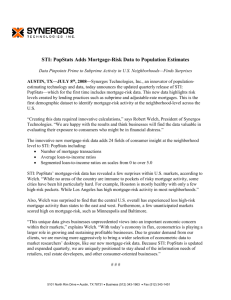VOT 78730 MATHEMATICAL MODEL OF SPEECH INTELLIGIBILITY IN MOSQUE WITH COLUMN PILLARS
advertisement

VOT 78730 MATHEMATICAL MODEL OF SPEECH INTELLIGIBILITY IN MOSQUE WITH COLUMN PILLARS (MODEL MATEMATIK KEJELASAN PERCAKAPAN DI DALAM MASJID YANG BERTIANG) FAREHA ABDUL RAHMAN MOHAMAD NGASRI BIN DIMON MOKHTAR BIN HARUN SITI ZALEHA BADUL HAMID AHMAD HAFIZ BIN HUSSIN Jabatan Kejuruteraan Perhubungan Radio Fakulti Kejuruteraan Elektrik Universiti Teknologi Malaysia 2011 ii ACKNOWLEDGEMENT Praise to ALLAH who has given me the strength, the ability physically and both mentally to complete this research grant (VOT No. 78370). Sincere appreciation and thank goes to the followings. Researchers of this grant who have contributed accordingly, Mr Ahmad Hafiz Hussin, that lead toward completion of this research. The Ministry of Higher Education (MOHE) for providing the research grant. Alhamdulillah with this grant, Appreciation also goes to the Research Management Centre (RMC UTM) for managing the duties on progress report and financial flow. The Senior Technician of Acoustics laboratory, Mr Adnall Bakar, and many others who are directly or indirectly involved giving support and suggestions, and contributing towards the completion of this research work. Thank you. iii ABSTRACT (Keywords: Speech intelligibility, mosque with column pillars, sound pressure level, reverberation time) The mosques in Malaysia are normally built in large scale with at least 280 m3 in volume. These large mosques usually have domes as partial of the ceiling and column pillars to support the large areas of the ceiling. The existence of domes and column pillars in large rooms can introduce a problem in speech intelligibility. Column pillars in the main prayer hall are usually covered with decorated tiles which are very reflective surfaces. The reflected sounds from such surfaces can create sound shadow zone between those pillars. This research explores effects of the column pillars in mosque towards speech intelligibility. This fundamental knowledge is required for optimum audio quality and predicting speech intelligibility for mosque. The research objectives are to conduct topology study of column pillars in mosques, to perform parameters selection in mosques with column pillars to evaluate its speech intelligibility, and to quantify the speech intelligibility in mosques with column pillars. From analysis of the result it can be concluded that the number of room samples chosen, and the number of measured speech intelligibility scores are sufficient to predict speech intelligibility in room with column pillars. By using only two room dimension parameters, the DSL and DFL in this case, the developed mathematical expressions have already achieved credible minimum coverage of statistical data of credible prediction accuracy of 71%. The mathematical expression development improved to a significant minimum coverage of statistical data of credible prediction accuracy of 93% when four room dimension parameters have been used. Key researchers: Mrs Fareha Abdul Rahman (Project Leader) Dr. Mokhtar Harun Assc. Prof. Dr. Mohamad Ngasri Dimon Mrs Siti Zaleha Abdul Hamid Mr Ahmad Hafiz Hussin E-mail : fareha@fke.utm.my Tel. No. : 075535219 Vote No. : 78370 iv ABSTRAK (Kata kunci:Kecekapan percakapan, masjid bertiang, aras tekanan bunyi, masa gemaan) Masjid di Malaysia kebiasaannya dibina dalam skala besar sekurang-kurangnya 280m3 isipadu. Masjid yang besar ini selalunya mempunyai kubah sebagai sebahagian bumbungnya, dan tiang-tiang utama untuk mengukuhkannya. Kewujudan kubah dan tiang-tiang ini boleh menimbulkan masalah dalam kejelasan percakapan. Tiang-tiang utama ini biasanya dibaluti dengan jubin yang bersifat memantul. Pantulan bunyi dari permukaan tersebut boleh menghasilkan zon terlindung bunyi di kawasan antara tiang. Penyelidikan ini mengkaji kesan tiang utama di dalam masjid terhadap kejelasan percakapan. Pengetahuan asas ini perlu untuk menghasilkan kualiti bunyi yang optimum dan seterusnya meramalkan kejelasan percakapan untuk masjid. Objektif penyelidikan ini adalah untuk memulakan kajian topologi tiang utama masjid, untuk mendapatkan parameterparameter yang bersesuaian dalam masjid bertiang bagi menilai kejelasan percakapan, dan untuk menyatakan kuantiti kejelasan percakapan di dalam masjid bertiang utama. Penyelidikan ini merumuskan jumlah sampel ruang yang dipilih, dan jumlah skor kejelasan percakapan adalah cukup untuk meramalkan kejelasan percakapan di dalam masjid yang bertiang. Menggunakan hanya dua parameter, DSL dan DFL , rumusan matematik yang dihasilkan telah mencapai liputan minima data statistik ketepatan ramalan yang boleh dipercayai sebanyak 71%. Rumusan matematik yang dihasilkan diperbaiki dengan liputan minima data statistik ketepatan ramalan yang boleh dipercayai bertambah sehingga 93% apabila empat parameter ruang digunapakai. Kunci penyelidik: Mrs Fareha Abdul Rahman (Project Leader) Dr. Mokhtar Harun Assc. Prof. Dr. Mohamad Ngasri Dimon Mrs Siti Zaleha Abdul Hamid Mr Ahmad Hafiz Hussin E-mail Tel. No. Vote No. : fareha@fke.utm.my : 075535219 : 78370 v TABLE OF CONTENTS CHAPTER 1 2 TITLE PAGE TITLE i ACKNOWLEDGEMENT ii ABSTRACT iii ABSTRAK iv TABLE OF CONTENTS v LIST OF TABLES vii LIST OF FIGURES viii LIST OF SYMBOLS ix LIST OF ABBREVIATIONS x INTRODUCTION 1.1 Background of the research 1 1.2 Research Objective 2 1.3 Research Scope 2 1.4 Report Outline 3 LITERATURE REVIEW 2.1 Introduction 4 2.2 Sound Absorption in Enclosed Room 4 2.3 Reverberation Time (RT60) 6 2.4 Room Acoustic 7 2.4.1 Initial Time Delay Gap (ITDG) 2.5 Speech Intelligibility 2.5.1 Speech Transmission Index (STI) 7 8 9 vi 3 4 5 METHODOLOGY 3.1 Introduction 12 3.2 Research Flow Chart 12 3.3 Selection of Room Samples 14 3.4 Selection of Acoustic and Room Parameters 15 3.5 Measurement Positions and Points 17 RESULTS AND DATA ANALYSIS 4.1 Introduction 18 4.2 Development of Mathematical Expression 18 CONCLUSION 5.1 Conclusion 21 5.2 Recommendation for future work 22 REFERENCES 23 vii LIST OF TABLES TABLE NO. TITLE PAGE 2.1 Speech intelligibility rating of STI 11 3.1 Selected room samples for the research 12 3.2 Selected acoustics and room parameters for the 16 research 4.1 Developed mathematical expressions of STI with respect to room dimensions. 19 viii LIST OF FIGURES FIGURES NO. TITLE PAGE 2.1 Reflection, absorption and transmission. 5 2.2 Relationship between Sound Intensity and Relative 6 Sound Level with Time 2.3 Section view of room sample showing calculation of 8 initial-time-delay gap (ITDG) via Ray Tracing 3.1 Research Flow Chart 13 3.2 Plan layout of a room sample 14 3.3 Side view of a room sample 15 3.4 Room parameters 16 3.5 Measurement location and points of measurement of acoustic parameter 17 ix LIST OF SYMBOLS α - Absorption coefficient Ei - Incident sound energy Er - Reflected energy Ea - Absorbed energy Et - Transmitted energy δ - Dissipation coefficient τ - Transmission coefficient S - Surface area of material V - Volume of the reverberation room r1 - Distance of direct sound r2 - Distance of reflected sound d1 - Distance of direct path from listener-to-receiver c - Speed of sound in air fm - m - S/N - DSL - DFL - DS1R - DBWL - dB - One-octave modulating frequency from 0.63 Hz to 12.5 Hz Resultant reduction factor Sound pressure level difference between signal and background noise Distance between sound source and listener (m) Distance between front wall and listener (m) Distance between sound source and first reflection (m) Distance between center of back wall and listener (m) Decibel x LIST OF ABBREVIATIONS RT60 - Reverberation Time STI - Speech Intelligibility Index ITDG - Initial Time Delay Gap 1 CHAPTER 1 INTRODUCTION 1.1 Background of the Research This research explores the effects of the column pillars in mosque towards speech intelligibility. This fundamental knowledge is required for optimum audio quality and predicting speech intelligibility for mosque. Many mosques in Malaysia are large. Except the for main prayer floor that is normally fully carpeted, the wall and ceiling are made of hard and reflective materials. With huge volume and hard reflective surfaces, sound reflection in mosques is massive and thus contribute to poor speech intelligibilty. In addition, the column pillars create shadow that may degrates speech intelligibility. For other fellow researchers, the outcomes of this research will strengthen current and available knowledge in terms of good result of speech intelligibility in mosque during any events. The addition of reflective dome and column pillars is expected to affect the speech intelligibility inside a large mosque. The electro acoustics room designers will have more options of what frequency to work on in their filter design so that better noise filtration and bigger attenuation can be achieved. It would be more practical to design noise filter, canceller, and attenuator 2 for this specific environment rather than to have current design of all-in-one on the shelf to fit in audio system in a room. Finally, the community which is the congregation will benefit intelligible, noise free and comfortable loudness sermon or any speech related activity in large mosques. 1.2 Research Objective The following discussions illustrate the undertaken research objectives. i To conduct topology study of column pillars in mosques to get the effect compare to the mosque without the column pillars. ii. To perform parameters selection in mosques with column pillars so as to evaluate speech intelligibility in it. iii. To quantify the speech intelligibility in mosques with column pillars. 1.3 Research Scope The researchers had used 01dB Symphonie frequency analyzer to perform the measurement of STI. STAT VIEW was used to analyze the data. The effects of speech intelligibility for the mosque with column pillars were conducted as to how speech intelligibility was affected in the whole mosque. 3 1.4 Report Outline This report is divided into five chapters, which describe the entire process of the research work. The outlines of the report are as follow: Chapter 1 highlights the background of the research problem and the objectives of the research. It is followed by research scope and report outline. Chapter 2 reviews the theory of sound absorption, reverberation time, and sound reflections that affect speech intelligibility Chapter 3 describes the research methodology and the measurement processes that have been made to the selected mosques with column pillars. Chapter 4 discusses the results from the measurements that had been conducted, and the results from the STAT VIEW modeling works. Chapter 5 concludes the findings of the research work. It also provides the suggestion for future development of the related research project. 4 CHAPTER 2 LITERATURE REVIEWS 2.1 Introduction The theories of sound absorption, reverberation time, and sound reflections that affect speech intelligibility are elaborated in this chapter. 2.2 Sound Absorption in Enclosed Rooms When the sound wave impinges on an acoustic material, some energy will be absorbed while some energy will be reflected depend on the material’s sound absorption performance. For instance, the sound absorption coefficient ( α ) is 0.4 if 60% of the incidence energy is reflected but the other 40% of remaining energy is absorbed. When all the incidence energy transferred to the other side of the window or open window phenomena or perfect absorbed will occur, which results in α = 1.0. Sound absorption of an acoustic material varies with frequency and angle of incidence of the sound waves impinge upon the material (Everest, 1994). When the sound energy is reflected from the wall, phenomena of sound refection is occurred which is opposite to sound absorption. Specular reflections will occur if the reflecting surface is large enough compared to the wavelength of the incidence energy. 5 When a sound impinges a wall, its incident sound energy Ei will be divided into three parts which are reflected energy E r , absorbed energy E a , and transmitted energy Et as illustrated in Figure 2.1. This phenomena can be written as follows. (Maekawa and Lord, 1994). Ei = E r + E a + Et (2.1) The absorption coefficient, α is defined as follows α= Ei − E r E a + Et = Ei Ei (2.2) Ei Ea Er Figure 2.1 Reflection, absorption and transmission. The Equation 2.2 above shows that all portions of the sound energy which are not reflected are considered to be absorbed. According to Sabine, sound absorption coefficient, α is defined by the ratio between the non-reflected sound intensity and the incident sound intensity. Sabine ( α ) is comprised of dissipation coefficient ( δ ) and transmission coefficient ( τ ). α = δ +τ (2.3) 6 2.3 Reverberation Time (RT60) Reverberation time is the time required for the sound level in the room to decay 60 dB or the time when sound energy left is only one-millionth millionth of its initial energy. RT60 is the time needed ffor a loud sound to be inaudible after the sound source is turned off.. This concept is shown in the following diagram. Figure 2.2 Relationships between Sound Intensity and Relative Sound Level with Time (Azman Jaafar, 1981). RT60 is good enough to describe characteristics eristics of sound build up and attenuation in the room. In case the sound in the room is not diffused enough, such as rooms with good absorption surfaces in some areas, or with an unusual shape long ( and narrow, very low ceiling, or many different focusing focusing surfaces), the RT calculation will not be accurate. The optimum reverberation time for different rooms dependon the volume of the space, finishes of the room, and the frequency of the sound concerned. In general, the optimum RT60 for rooms for speech is less than n the optimum RT60 for rooms used for music. music 7 Reverberation time (RT60) formula is given as the followings: RT60 = 0.1 6V (2.4) Sα Where: V = Volume of the room, m3 S = Total surface area of the room, m2 α = absorption coefficient of the surface, material or finishes of the room 2.4 Room Acoustic The propagation of sound is bounded by walls, ceiling and floor of the room. These room boundaries usually reflect a certain fraction of the sound impinging on them. If the energy of sound is not absorbed or extracted from the sound field inside the room, the sound will be reflected. The reflected sound component is responsible for what is known as ‘the acoustics of a room’. These reflected sound components will cause the reverberant field in the room to increase. This is the complexity of the sound field in a room (Cremer and Muller, 1982). From Eqs. 2.2, it is found that absorption of sound will be smaller if reflected energy E r is bigger. 2.4.1 Initial Time Delay Gap (ITDG) Initial time delay gap (ITDG) is defined as the difference between time taken for a complete first sound reflections and the time taken for the direct sound path to reach the listener (Burroughs, 2001 ). Alternatively, as shown Figure 2.3, 8 (r + r ) − d1 ITDG = 1 2 c (2.5) Where; r1 is the distance of direct sound, in meter r2 is the distance of reflected sound, in meter d1 is the distance of direct path from listener-to-receiver, in meter c is the speed of sound in air, m/s Dome height, DH Reflected path, r2 Incident path, r1 Room height, RH Direct path, d1 Listener Width of room, W Fig ure 2.3 Section view of room sample showing calculation of initial-time-delay gap (ITDG) via Ray Tracing (Burroughs, 2002) 2.5 Speech Intelligibility Speech intelligibility is the ability to understand spoken message, necessary for communication, announcement and instruction for safety. Longman Dictionary of Contemporary English (1978) defines speech intelligibility as “speech that can be 9 understood”. According to Mapp (1999) speech intelligibility describes the ability to distinguish the structure of the speech sound, and to be able to hear the consonants or vowels of a word without masking. Templeton et al. (1993) asserts that the ability to hear a speech is not as same as to be intelligible upon hearing a speech. Speech intelligibility is established when the listener hears the word that is uttered by a speaker and the word is not mistaken with other word. 2.5.1 Speech Transmission Index (STI) STI is a speech intelligibility assessor that quantifies the effect of sound transmission system upon speech intelligibility. It is based upon an analysis of the reduction in intensity modulation of a signal, which occurs along the transmission path from the sound source to the listener. STI equals 1 is for perfect sound transmission and STI equals 0 is for no signal recognition (Templeton et al., 1993a) STI had been established by Houtgast and Steeneken in 1980 (Houtgast and Steeneken, 2002). Speech disturbances in room such as background noise and reverberation result in reduced speech intelligibility. Modulation Transfer Function (MTF) is employed in STI to evaluate speech intelligibility in room with such disturbances (Houtgast and Steeneken, 1985). Mathematically, STI is defined by the following formula. STI = Where; ( S / N ) + 15 30 (2.6) 10 7 ( S / N ) = Σ (Wk )(S / N )app, k k =1 (2.7) m ( S / N ) app, k = 10 log 1− m (2.8) (S/N)app,k is calculated over each octave band of noise from 125 Hz to 8000 Hz. And m( f m ) = 1 S / N 1/ 2 − 2πf T 2 m 10 1+ 1 + 10 13.8 fm the one-octave modulating frequency from 0.63 Hz to 12.5 Hz m is the resultant reduction factor of each m(fm) S/N is the sound pressure level difference between signal and background noise STI = 0, when (S/N)app.k << -15 dB STI = 1, when (S/N)app.k >> 15 dB T is the reverberation time or RT60 (in second) 11 Table 2.1 Speech intelligibility rating of STI (Templeton et al., 1993c) RATING STI Score Bad Poor Fair Good Excellent STI < 0.3 0.3 to 0.45 0.45 - 0.6 0.6 to 0.75 STI > 0.75 CHAPTER 3 METHODOLOGY 3.1 Introduction Research flow chart, selection of room samples and parameters used for the research, and data acquisition process are described in this chapter. 3.2 Research Flow Chart It is shown in Figure 3.1. Table 3.1 Selected room samples for the research Room samples Masjid Tangkak (TNK) Masjid Kpg. Jawa (SEG) Masjid IKBN Pagoh (IKBN) Masjid Sedili (SED) Masjid Tandop Alor Setar (TAN) Length (m) Width (m) Height (m) Surface area (m2) Volume (m3) 46 35 25 4390 11460 29 25 21 2350 6400 30 25 20 2380 6560 29 25 20 2300 6750 27 24 14 1850 3750 13 Problem formulation START Select room samples Select room and acoustics parameters Data acquisition Data analysis (Modeling using STATVIEW) Conclude the findings END Figure 3.1 Research Flow Chart 14 3.3 Selection of Room Samples It is tabulated in Table 3.1. Plan layout and side view of room samples are shown in Figure 3.2 and Figure 3.3 respectively. Mihrab at front of the mosque Four (4) column pillars Back area of the mosque Figure 3.2 Plan layout of a room sample 15 Column pillars Mihrab at front of the mosque Back area of the mosque Figure 3.3 Side view of a room sample 3.4 Selection of Acoustics and Room Parameters It is tabulated in Table 3.2. Room parameters are depicted in Figure 3.4. 16 Table 3.2 Selected acoustics and room parameters for the research Parameters Length (m) Unit Acoustics STI - Room DSL DFL DS1R meter (m) meter (m) meter (m) DBWL meter (m) Description Speech intelligibility assessor that returns speech intelligibility score by evaluating sound response over octave frequency range of 125 Hz to 8 kHz Sound source to listener distance Front wall to listener distance Sound source to the center at tip of the dome Mid section of back wall to listener distance Figure 3.4 Room parameters 17 3.5 Measurement Positions and Points Figure 3.5 shows location and points of measurement of acoustics parameter. For this research, the measurement of STI was the concern. Mihrab at front of the mosque Four (4) column pillars Back area of the mosque Figure 3.5 Measurement location and points of measurement of acoustic parameter CHAPTER 4 RESULTS AND DATA ANALYSIS 4.1 Introduction In this chapter the mathematical expressions developed are discussed. 4.2 Development of Mathematical Expression The developed modeling expressions are tabulated in Table 4.1. The mathematical expression development begins by using two room dimension parameters, in all five samples. The parameters used were DSL and DFL. They were tested against speech intelligibility assessor, STI. It has been found out that through correlation coefficients R2, the developed two-parameters mathematical expressions have accuracy ranging from 0.71 to 0.92. 19 Table 4.1 Developed mathematical expressions of STI with respect to room dimensions. MOSQUES STI vs DSL (m), DFL (m) STI vs DSL (m), DFL (m), DS1R (m) IKBN STI = 0.6080.051DSL+0.034DFL ; P-Value = 0.0146 R2 = 0.879 SEGAMAT STI = 0.779-0.008DSL0.005DFL ; P-Value =0.0212 R2 = 0.723 STI = 0.6560.045DSL+0.035DFL0.008DS1R ; P-Value = 0.0494 R2 = 0.903 STI = 0.795-0.004DSL0.006DFL-0.004DS1R ; P-Value = 0.0717 R2 = 0.726 TANGKAK STI = 1.112+0.027DSL0.036DFL ; P-Value = 0.0033 R2 = 0.852 STI = 1.085+0.022DSL0.034DFL+0.005DS1R ; P-Value = 0.0152 R2 = 0.856 TANDOP STI = 0.7290.030DSL+0.016DFL ; P-Value = 0.0465 R2 = 0.707 STI = 0.868+0.031DSL0.061DFL+0.033DS1R ; P-Value = 0.0141 R2 = 0.912 SEDILI STI = 0.6010.065DSL+0.046DFL ; P-Value = 0.0208 R2 = 0.924 STI = 0.669-0.063DSL +0.058DFL-0.019DS1R ; P-Value = 0.0877 R2 = 0.941 STI vs DSL (m), DFL (m), DS1R (m), DBWL (m) STI = -11.1290.004DSL+0.364DFL+ 0.011DS1R+0.410DBWL ; P-Value = 0.0060 R2 = 0.997 STI = -5.4390.016DSL+0.198DFL+ 0.010DS1R+0.217DBWL ; P-Value = 0.0129 R2 = 0.933 STI = 831.876+0.068DSL+ 17.887DFL0.122DS1R+17.921DBWL ; P-Value = 0.0027 R2 = 0.970 STI = -56.431+0.061DSL+ 2.023DFL0.084DS1R+2.146DBWL ; P-Value = 0.0006 R2 = 0.996 STI = -0.5260.007DSL+0.055DFL0.017DS1R+0.053DBWL ; P-Value = 0.1316 R2 =0.992 The mathematical expressions later on were developed by using three room dimension parameters. The parameters used were DSL, DFL , and DS1R . They were tested against speech intelligibility assessor, STI. It has been found out that the R2 of the developed three-parameters mathematical expressions have accuracy ranging from 0.73 to 0.94. 20 Finally, the mathematical expressions were developed by using four room dimension parameters. The parameters used were DSL, DFL , DS1R, and DBWL that were tested against STI. It has been found out that the R2 of the developed four-parameters mathematical expressions have accuracy ranging from 0.93 to 0.99. CHAPTER 5 CONCLUSIONS 5.1 Conclusion From analysis of the result it can be concluded that: i. The number of room samples chosen, and the number of measured speech intelligibility scores are sufficient to predict speech intelligibility in room with column pillars. ii. By using only two room dimension parameters, the DSL and DFL in this case, the developed mathematical expressions have already achieved credible minimum coverage of statistical data of credible prediction accuracy of 71%. iii. The chosen room dimension parameters for this research, for mathematical expression development have achieved significant minimum coverage of statistical data of credible prediction accuracy of 93%. 22 5.2 Recommendations for future works The recommendations for future work are as follows. i. The per room sample mathematical expressions developed shall be normalized as per all room samples. ii. The room samples with lower p-value shall be checked for variance and data discrepancies so as to increase the coverage of statistical data and thus increase prediction accuracy. iii. Mathematical expressions shall be developed from plan layout point of view of the chosen room samples. 23 REFERENCES Burroughs, C. (2001). Architectural Acoustics. Pennsylvania State University State College Pennsylvania USA: Lecture Notes. 1-237. Cremer, L., Muller, H. A., Schultz, T. J. (1982). Principles and Applications of Room Acoustics. London and New York: Applied Science Publishers. 1. 140-141. Everest, F.A. (1994). The Master Handbook of Acoustics. 3rd edition. TAB Books. New York. Houtgast, T. and Steeneken, H. J. M. (1985). The Modulation Transfer Function in Room Acoustics. Technical Review. Bruel and Kjaer No.3 –1985. Houtgast, T. and Steeneken, H. J. M. (2002). The Roots of the STI Approach. International Symposium on Past, Present and Future of Speech Transmission Index (STI), Soesterberg, Holland. 3-11. Longman. (1978). Dictionary of Contemporary English. Clays Limited: United Kingdom. 547. Mapp, P. (1999). Reaching the Audience. The International Management and Engineering Journal for System Contractors and Consultants (S&VC). 17(11). 17-32. Maekawa, Z and Lord. P (1994). Environmental and Architectural Acoustics. E & FN SPON. London. Templeton, D. (Ed.), Sacre, P., Mapp, P., Saunders, D. (1993). Acoustics in the Built Environment. Oxford: Butterworth-Heinemann Ltd. 122. 24 Templeton, D. (Ed.), Sacre, P., Mapp, P., Saunders, D. (1993a). Acoustics in the Built Environment. Oxford: Butterworth-Heinemann Ltd. 140-142.







